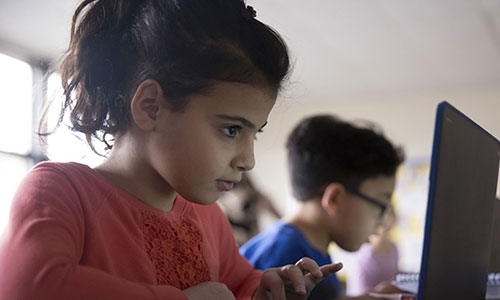
Growing up in the Midwest, the winter was always a difficult time to stay motivated in school. Tearing myself away from a warm bed to wait at a cold and dark bus stop didn’t exactly help me stay energized for learning. In the middle of a journey like a school year, keeping focus on our objectives can be one of the biggest challenges. Student goal setting can help provide that focus.
In the fall, I shared some ideas on using goals to organize the excitement and overwhelm of the beginning of the year. Here I want to focus on using goals to connect with individual students at the time when it is perhaps the most difficult.
The role of MAP Growth in the winter
A winter MAP® Growth™ score can bring a student excitement about what they have achieved, and it can also bring some disappointment about how far there is to go.
We shouldn’t shy away from data. It’s difficult to stay motivated for the journey if we don’t even know where we’re going or how close we are to getting there. MAP Growth can also help us step back from day-to-day instruction and understand where a student is more broadly within a content domain, reinforcing why the day-to-day activities matter. But the midpoint of the school year is also the most important time to understand how each of our students feels about that journey and uncover the tools and supports they need to make it more successful.
In Step into Student Goal Setting: A Path to Growth, Motivation, and Agency, I argue that one-on-one conversations are key to goal-setting practices that are relevant and functional for learners. Making the time and space for each student as an individual can seem a daunting task. However, the book provides some important strategies for using your conversations to build student ownership and agency, which can help students take on more of the logistical burden. Begin by discussing MAP Growth scores, but don’t stop there.
Tips on talking with students from Step into Student Goal Setting
As you review the following passage, consider all the opportunities you may have in a school day to check in with where your students are in working toward their goals. Even a five-minute conversation can provide invaluable insights and continuing motivation that can help students see the full forest of learning, even if the trees are covered by a little winter snow.
“One-on-one conversations with students are the foundation of an effective goal-setting practice. Goals must be personal in order to be truly relevant for learners. While class-level goals can help guide instruction and provide students with ways to connect with one another, personal learning goals let students convert their dedication to the learning of their class into the self-confidence and agency necessary to see themselves as ambitious learners.
“One-on-one conversations are invitations to students to engage in co-constructing their goals with their teacher. In one-on-one conversations, teacher and student work together to understand how the student is learning, what the student’s next goal should be, and what the student should do in order to get to that goal. They leave the conversation having plotted or better understood together that student’s learning journey, with each of a student’s goals serving as another mile marker on the road.
Focus on student strengths and opportunities for growth rather than the places they’ve fallen short.
“These conversations also provide the teacher with the chance to do some intelligence gathering on student needs. While some students are eager to volunteer all the details about their lives, others need support to reveal everything the teacher needs to know to best serve them as an instructor, an advocate, or a mentor. One-on-one conversations provide the appropriate environment to ask probing questions about a student’s strengths and the barriers to their learning that they can identify. I spoke with STEM teacher Matthew Marchoyok, who works with middle and secondary students on college and career readiness, and leverages goals as an important part of tying what he teaches directly to student concerns. ‘Conversation and connection,’ he says, ‘are applications of learning.’
“The types of questions you ask in a goal-setting conversation and the language used in those questions communicate to students how you understand learning and play a major role in how they come to understand learning. When crafting your language, focus on student strengths and opportunities for growth rather than the places they’ve fallen short. Where possible, create opportunities for students to make meaning of their learning rather than making that meaning for them. Use questions to elicit evidence of students’ thinking rather than opportunities to introduce your own perspectives.
“To be most effective, those conversations and connections should be frequent—for example, held monthly or even weekly with each student. There’s no doubt that such an investment of time is significant for any teacher, and the commitment may seem daunting at first glance. There are a few ways to make this challenge more manageable:
“Consider how existing structures in your classroom can support goal setting. Many classrooms use reading and writing workshops or math groups in which teacher/student conferring is already an important component. These conferences provide a natural opportunity to think about a student’s goals, and a goal-setting process can be easily folded into these existing conversations. Keeping the conversations informal may make things easier. Oftentimes, short, frequent conversations can have more impact than longer, more scripted ones. While this chapter provides a series of tools to guide goal-setting conversations, some of these check ins can focus on updating an existing plan for a student rather than making a whole new plan. Track conversations in the way that makes the most sense for you. It’s not necessary to keep an extended, formal report from each time you sit down with a student. Instead, something like an ongoing page in a notebook (or document on a computer) for each student can provide a quick way to jot down evidence of their progress toward a goal or considerations for your next conversation. Wherever possible, involve students in keeping their own logs of conversations….
“While the initial time investment in a goal-setting process can be substantial, goal setting in the long term can create greater efficiency in your planning by more equitably sharing responsibilities between teachers and students. When students can take greater control over their learning, they’re able to become more self-directed, engage in more activities without direct teacher supervision, and make more choices about what they’re ready to learn next.”
Keep exploring goal setting
Goal setting is a powerful practice for any classroom. For more on how to get the most out of it, listen to our podcast, The Continuing Educator, or watch my recorded webinar “Goals mean growth: Using student goal setting to jumpstart student motivation and success.”







